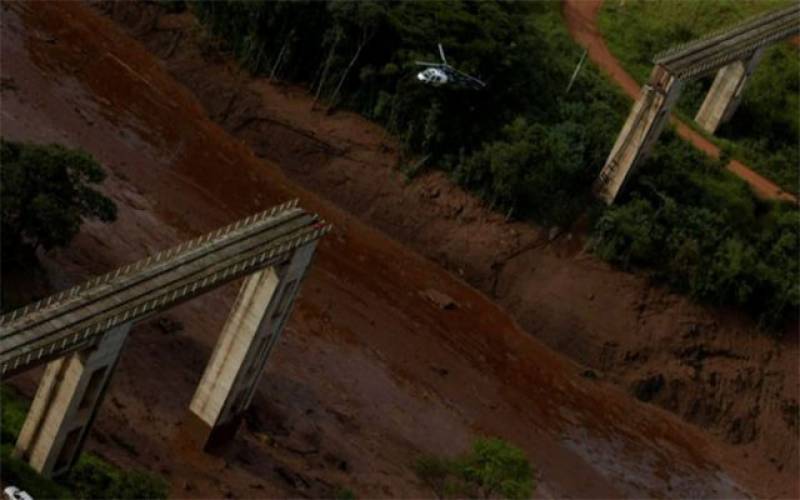Brumadinho (Agencies): At least nine bodies were recovered and more than 300 people remain missing after a mining dam collapsed in southeast Brazil.
Seven bodies were recovered Friday hours after the disaster, after a torrent of mud broke through the dam at the iron-ore mine close to the city of Belo Horizonte, in the state of Minas Gerias, around 1pm local time.
By early Saturday the official death toll had risen to nine, local firefighters said, who also doubled the number of people presumed missing from the previous toll to nearly 300 people.
Mr Romeu Zema, the governor of Minas Gerais, told reporters that while all was being done to find survivors, “from now, the odds are minimal and it is most likely we will recover only bodies”.
Brazil’s new president Jair Bolsonaro, who rushed home from the World Economic Forum in Davos, Switzerland, is scheduled to fly over the disaster zone Saturday along with his defence minister.
The mine is owned by Brazilian mining giant Vale. It was involved in a 2015 mine collapse in the same state that claimed 19 lives and is regarded as the country’s worst-ever environmental disaster.
Vale shares plummeted on the new accident, losing eight per cent in New York trading.
Minas Gerais officials obtained a court order blocking Vale’s bank account in the state to the tune of US$270 million (S$365.55 million), money that would used for victim relief, according to the G1 news website.
The massive, muddy flow from the collapse barreled towards the nearby town of Brumadinho, population 39,000, but did not hit it directly.
Instead, it carved its way across roads, vegetation and farmland, taking down a bridge, and damaging or destroying homes.
Television images showed people being pulled out of waist-high mud into rescue helicopters, dozens of which were in use by late Friday because land access had been cut off.
Brazil’s new government reacted to its first major emergency by launching disaster coordination between the defence, mining and environment ministries and the authorities in the affected state of Minas Gerais.
Bolsonaro’s environment minister raced to the area late Friday.
“Where are our relatives?” wailed Ms Raquel Cristina, one of several people demanding information about their missing kin in the mud-hit area.
“My five-year-old nephew is asking me if his dad died. What do I tell him?” asked another, Ms Olivia Rios.
Some of the firefighters used earth-moving machinery to dig down to engulfed dwellings.
Would-be rescue volunteers were warned away because of the slippery, perilous piles of mud. Media were urged not to use drones to avoid collisions with the helicopters.
Up to 150 of those missing worked in the company’s administrative offices which were closest to the dam break, the firefighters said.
Mr Walter Morais, a member of the Red Cross team sent to the disaster zone, told a foreign news agency that his relief group “will begin humanitarian actions helping people who were rescued and are homeless”.
Vale CEO Fabio Schvartsman called the incident a “human tragedy” and was resigned to more deaths being confirmed at his company’s mine.
“We’re talking about probably a large number of victims – we don’t know how many but we know it will be a high number,” he told a media conference in Rio de Janeiro.
Mr Schvartsman, who had his two-year term renewed last month by Vale’s board, said it was an “inactive dam” that was in the process of being decommissioned that burst apart “very violently, very suddenly”.
Its contents – tailings, or mining byproducts mixed with water – cascaded into another dam, which overflowed, he said.
The disaster recalled trauma from the 2015 dam break near Mariana, in Minas Gerais. That accident released millions of tons of toxic iron waste along hundreds of kilometers.
Vale was joint operator of that dam, along with the Anglo-Australian group BHP.
The Brazil office of Greenpeace, the environmental activist group, said Friday’s dam break was “a sad consequence of the lessons not learned by the Brazilian government and the mining companies”.
Such incidents “are not accidents but environmental crimes that must be investigated, punished and repaired”, it added.


